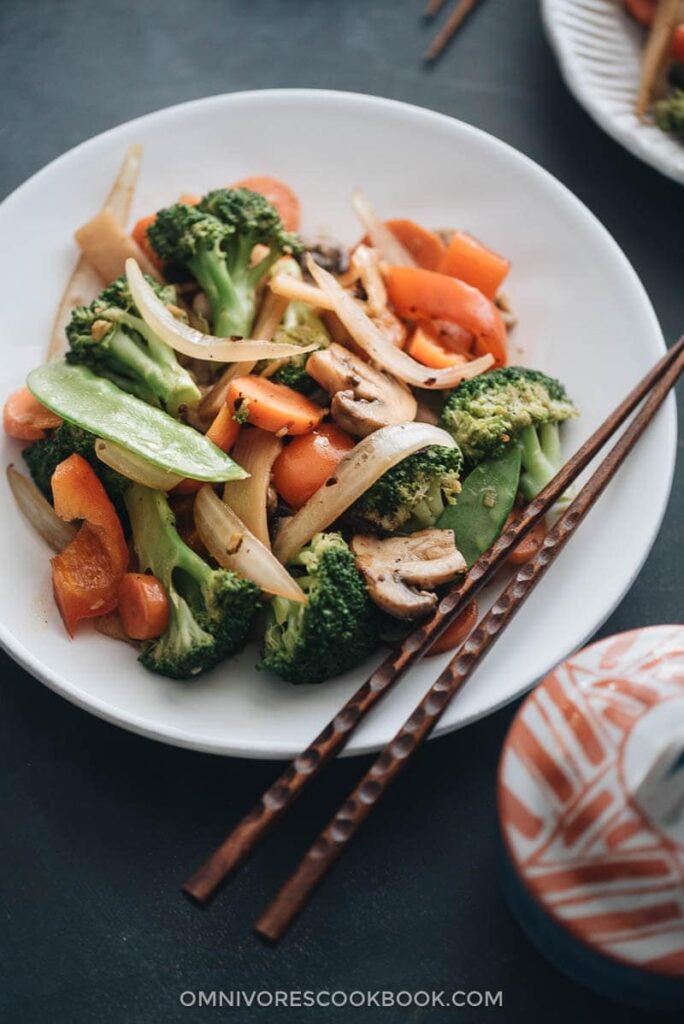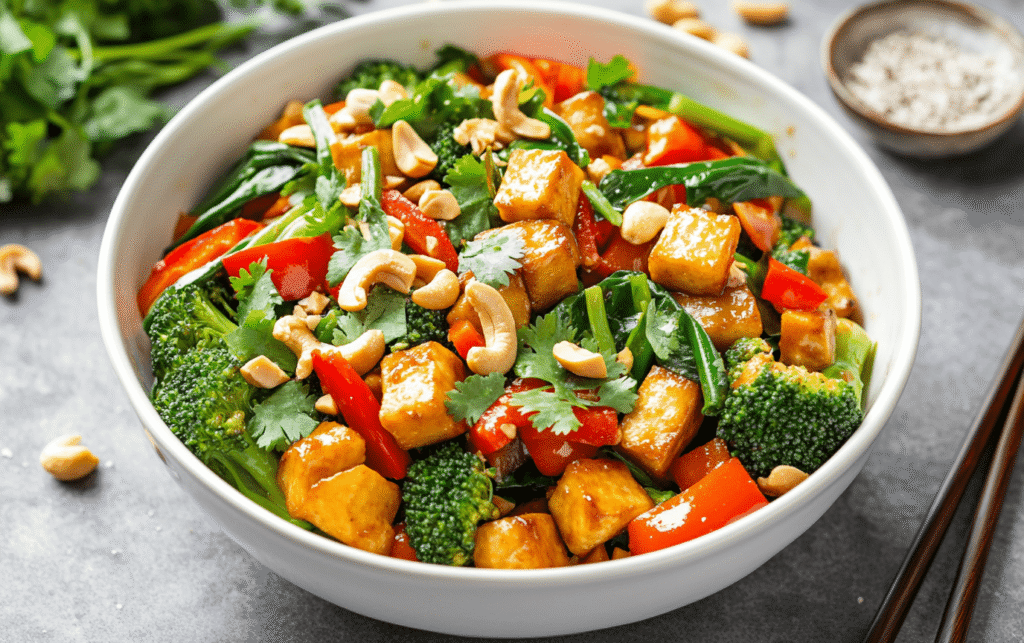A delicious stir-fry dish. It’s quick, easy, healthy, customizable, and packed with nutrients. Whether you’re a busy parent, a health-conscious student, or someone simply trying to eat more vegetables, learning how to master this dish will transform your weekly eating routine.
In this comprehensive guide, we’ll explore everything from the benefits of stir-frying to ingredient selection, preparation tips, and even a tried-and-true recipe. Along the way, we’ll uncover the secrets to creating a stir-fry dish that’s rich in color, texture, and flavor.
Why Choose Vegetable Stir Fry?
The Vegetable Stir Fry isn’t just another dish; it’s a gateway to healthy, delicious eating. Here’s why it should be in your regular meal rotation:
- Quick and Easy: Most stir fry recipes can be made in under 30 minutes. That makes them ideal for weeknight dinners.
- Nutrient-Rich: Stir-frying retains more nutrients compared to boiling or overcooking vegetables.
- Flexible and Customizable: Don’t like bell peppers? Swap them out. Have some broccoli about to go bad? Toss it in.
- Budget-Friendly: You can create a flavorful stir fry with affordable, seasonal produce.
- Minimal Cleanup: One wok or skillet is usually all you need.
Essential Ingredients for the Perfect Vegetable Stir Fry
A good Vegetable Stir Fry starts with the right ingredients. Here’s what you need:
1. Fresh Vegetables
Choose a mix of colors, textures, and flavors. Some common favorites include:
- Bell peppers (red, green, yellow)
- Broccoli florets
- Carrots
- Snap peas
- Mushrooms
- Baby corn
- Zucchini
- Cabbage
The variety not only enhances the visual appeal but also ensures a range of nutrients and flavors.
2. Aromatics
Garlic, ginger, and onions form the aromatic base. They infuse the oil with flavor and elevate the taste of the entire dish.
3. Sauce
A well-balanced stir fry sauce is crucial. You can go with store-bought sauces, but homemade is usually better. A basic sauce might include:
- Soy sauce
- Sesame oil
- Rice vinegar
- A touch of honey or maple syrup
- Cornstarch slurry for thickening
4. Protein (Optional)
Though it’s not necessary for a Vegetable Stir Fry, you can always add tofu, tempeh, or even eggs if you prefer a protein boost.
5. Oil
Use an oil with a high smoke point. Sesame oil adds flavor but burns quickly, so mix it with canola or avocado oil for the best results.
Step-by-Step: How to Make Vegetable Stir Fry
Let’s break down the process into manageable steps:
Step 1: Prep Your Ingredients
Wash and cut all vegetables into uniform sizes to ensure even cooking. Pre-measure your sauce ingredients and keep everything ready—stir frying happens fast.
Step 2: Heat the Wok
A wok is ideal due to its shape and heat distribution, but a large skillet works too. Heat it until it’s smoking hot, then add your oil.
Step 3: Sauté Aromatics
Quickly fry garlic, ginger, and onions until fragrant. This only takes 30–60 seconds.
Step 4: Cook the Vegetables
Add harder vegetables like carrots and broccoli first. Softer ones like mushrooms or bell peppers come later. Stir continuously to avoid burning and ensure everything cooks evenly.
Step 5: Add Sauce
Pour in the sauce and stir well. If using a cornstarch slurry, add it now and cook for 1–2 more minutes until the sauce thickens and coats the vegetables.
Step 6: Garnish and Serve
Top your Vegetable Stir Fry with sesame seeds, chopped scallions, or a squeeze of lime. Serve over rice, noodles, or even quinoa.
Recipe: Classic Vegetable Stir Fry
Servings: 4
Prep Time: 15 minutes
Cook Time: 10 minutes
Ingredients:
- 1 cup broccoli florets
- 1 red bell pepper, sliced
- 1 carrot, julienned
- 1 cup snow peas
- 1/2 cup sliced mushrooms
- 2 cloves garlic, minced
- 1 inch fresh ginger, grated
- 2 tablespoons soy sauce
- 1 tablespoon sesame oil
- 1 teaspoon rice vinegar
- 1 teaspoon honey
- 1 teaspoon cornstarch (mixed with 2 tablespoons water)
- 1 tablespoon vegetable oil (for frying)

Instructions:
- Mix soy sauce, sesame oil, vinegar, honey, and cornstarch slurry in a small bowl. Set aside.
- Heat the vegetable oil in a wok over medium-high heat.
- Sauté garlic and ginger for 30 seconds.
- Add broccoli and carrots. Stir fry for 2 minutes.
- Add bell pepper, mushrooms, and snow peas. Cook for another 2–3 minutes.
- Pour in the sauce and stir to coat evenly.
- Cook for another 2 minutes, allowing the sauce to thicken.
- Remove from heat and serve hot.
Tips for a Better Stir Fry
Even a simple Vegetable Stir Fry can go wrong without proper technique. Here are some tips:
- Don’t overcrowd the pan: Cook in batches if necessary. Overcrowding leads to steaming rather than stir frying.
- Keep everything moving: Stir constantly to prevent sticking and burning.
- Adjust seasoning last: Always taste at the end and tweak if necessary.
- Use seasonal vegetables: Not only are they cheaper, but they’re also fresher and more flavorful.
Variations to Try
One of the best things about Vegetable Stir Fry is how easy it is to modify:
- Spicy Stir Fry: Add chili paste or fresh red chilies for heat.
- Thai-Inspired: Use a peanut sauce or coconut milk base.
- Chinese Style: Add hoisin sauce, oyster sauce (if not vegetarian), and a pinch of five-spice powder.
- Indian Twist: Toss in curry powder or garam masala for a unique flavor profile.
Health Benefits of Vegetable Stir Fry
The ingredients in a typical Vegetable Stir Fry offer numerous health benefits:
- Fiber: Supports digestion and helps control blood sugar.
- Antioxidants: Found in colorful veggies like bell peppers and broccoli, they fight oxidative stress.
- Low in Calories: Ideal for weight management when paired with a healthy grain like brown rice.
- Heart Health: Olive oil or avocado oil, along with fiber-rich vegetables, supports cardiovascular health.
Serving Suggestions
Here’s how to make your stir fry feel like a complete meal:
- Serve over steamed rice, jasmine, or basmati.
- Pair with noodles, like soba, ramen, or rice noodles.
- For a low-carb version, use cauliflower rice or zoodles (zucchini noodles).
- Add a side of miso soup or spring rolls for a full Asian-inspired dinner.
Final Thoughts
The Vegetable Stir Fry is a timeless dish that adapts to every season, diet, and craving. With the right technique, ingredients, and a little creativity, you can whip up a satisfying, nutritious meal in under 30 minutes. Whether you’re a vegetarian, a flexitarian, or just someone trying to eat more whole foods, stir frying is a skill worth mastering.
So next time you open your fridge and wonder what to cook with that half head of broccoli and lone carrot—think Vegetable Stir Fry.

